Postpartum Exercise: What You Need To Know Before Getting Started
I see so many moms trying to jump back into their postpartum workout routines only to be left frustrated and overwhelmed because things just don’t work or feel like they did prior to having a baby.
Figuring out how to navigate your new postpartum body may feel a little intimidating, daunting and overwhelming, right?
So where do you start?
As a mom of three, I know embracing your postpartum body is hard to do when things not only look different, but they feel and function differently as well.
Postpartum exercise is much more than changing the way our new bodies look but more importantly, how they function.
With a little knowledge, motivation and support, you CAN get back to doing the workouts you love.
And if you have never been a avid exerciser prior to pregnancy, thats okay, now is a great time to start.
But first, you really do need to understand just what your body has been through and how to begin healing from the inside out.
You need to start slow and think of your postpartum exercise plan as a journey, not a race.
And remember, each mama has her own unique journey so go at your own pace and do what feels right for you and your body.
(Disclaimer: Although I am a certified prenatal/postnatal exercise specialist and personal trainer, I am not YOUR trainer. The content on this blog is for informational purposes only and should not be a substitute of the information and advice you receive from a healthcare professional.
What You Will Learn
In this post, you will learn
- How your new postpartum body is different,
- what you need to know before jumping back into your postpartum workout routine
- 7 exercises to help you begin healing your body after having a baby.
Keep in mind that before resuming any exercise or movement after having a baby, please consult with your healthcare provider.
Every mom has her own unique pregnancy, delivery and postpartum experience and it is important to discuss postpartum expectations with your doctor.
The information provided is from both personal experience as well as extensive research through becoming a prenatal, postnatal exercise specialist with a bachelors degree in exercise science.
What To Expect After Delivery
No matter what anyone says, your postpartum body is different now.
Here are 7 changes that occur to our bodies as a result of pregnancy and childbirth.
These changes need mindful attention when returning to your postpartum workout routine.
- Diastasis Recti
- Abdominal separation. If left untreated, this can cause inconteinece, back pain and inability to “flatten” your tummy.
- Pelvic organ prolapse
- When the muscles and ligaments that support a woman’s pelvic organs weaken, such as during childbirth, the pelvic organs can drop lower in the pelvis, creating a bulge in the vagina. Source
- Wobbly Joints
- During pregnancy, our bodies release a joint softening hormone called “Relaxin”. This can cause weak and loose joints.
- During pregnancy, our bodies release a joint softening hormone called “Relaxin”. This can cause weak and loose joints.
- Fatigue
- Lack of sleep with a newborn can slow the postpartum healing process.
- Lack of sleep with a newborn can slow the postpartum healing process.
- Bleeding
- Postpartum bleeding, or lochia, is the heavy flow of blood and mucus that starts after delivery and continues for up to 10 days. Light bleeding and spotting after pregnancy can continue for up to four to six weeks after delivery. (source)
- Postpartum bleeding, or lochia, is the heavy flow of blood and mucus that starts after delivery and continues for up to 10 days. Light bleeding and spotting after pregnancy can continue for up to four to six weeks after delivery. (source)
- Loss of functionality
- Over stretching or injury to the nerves, ligaments, and pelvic floor muscles that support the bladder and keep the urethra closed can cause urinary incontinence.
- Over stretching or injury to the nerves, ligaments, and pelvic floor muscles that support the bladder and keep the urethra closed can cause urinary incontinence.
- Mood disorders
- Postpartum depression
- Postpartum anxiety
Related: Everything You Need to Know About Training Your Core After Having a Baby
Related: 5 Exercises to Strengthen Your Pelvic Floor After Pregnancy Healing
What Does Being “Cleared” To Exercise After Having a Baby Mean?
Being cleared to exercise after having a baby DOES NOT mean you should jump right back in where you left off or dive head first into a new workout routine.
It also doesn’t mean that prior to being cleared, you are restricted to do any movement at all.
Being cleared by your doctor is simply from a medical standpoint meaning you are medically healed to exercise.
HOWEVER, being medically cleared and physically ready are two entirely different things!
Think about it like this.
Women are told not to “exercise” prior to 6-8 weeks postpartum then cleared on day 43 to begin exercising.
How are we not “cleared” to exercise for 6-8 weeks then miraculously become healed on day 43 and ready to jump right back into our workouts?
This just doesn’t make sense!
Postpartum exercise is about rehabilitation and recovery rather than weight loss or “getting your body back.”
Related: Do I really need to Wait 6-8 Weeks Before Resuming My Postpartum Workout Plan?
Why is Postpartum Exercise Important?
By now, it should come as no surprise that pregnancy and childbirth create a lot of changes to our bodies.
These changes are often overlooked because pregnancy and childbirth are viewed as such a routine part of life.
The focus of your postpartum workout routine should be on rehabilitating and rebuilding for optimal strength, support and function.
Sure, most of us want to shed extra baby weight and feel confident in our postpartum bodies.
However, the main focus should be on healing and recovering.
And whether you exercise or not, the postpartum period can be very physically demanding.
Holding, bathing, nursing, taking your baby in and out of their crib, and wearing your baby in a carrier are all examples of how physically demanding motherhood can.
These demands can be extra challenging immediately postpartum or if you have other kids to take care of.
The Benefits Of Postpartum Exercise
Other extremely important benefits of exercising after having a baby include:
- Boost mood and reduce stress
- May help reduce postpartum depression and anxiety (source) (source)
- May help children develop habits for regular physical activity
- May improve heart health
- Reduce blood pressure and resting heart rate
- May improve quality of sleep
- Improve confidence and body image (Source)
Your postpartum workout routine should be focused on improving mobility, alignment, strength and function of the core and pelvic floor.
Having a good prenatal exercise program that focuses on maintaining core and pelvic floor strength may also help you to recover faster and return to your workouts sooner and with less setbacks.
10 Variables That May Affect Your Ability to Start Exercising After Having a Baby
So by now you’re probably wondering when is okay to resume postpartum exercise plan.
This waiting period is arbitrary.
Returning to exercise postpartum is not a one size fits all approach.
Everyone experiences a different pregnancy and delivery.
Here are 10 variables that may affect when you should resume exercise after having a by:
- Your activity level during pregnancy-
- Those who were physically active prior to pregnancy may be able to return to their workouts a little sooner.
- The length of your labor.
- Longer labor may lead to greater trauma.
- Where there complications or injuries during birth such as episiotomy, tearing, pelvic organ prolapse?
- Greater complications may lead to longer recovery times
- Did you experience pelvic pain or incontinence during pregnancy?
- Did you have more than one baby?
- A multiple baby pregnancy may take longer to recover.
- Delivery method-
- Vaginal or C-section will affect recovery time.
- Has bleeding stopped?
- Are you sleeping?
- Lack of sleep can slow down recovery time
- Do you have incontinence or heaviness in your pelvis after giving birth?
- These are signs that you have weakness in your core and pelvic floor
- Do you have abdominal separation knows as Diastasis Recti?
Related: Everything you need to know about training your core after having a baby
6 Signs You Are Doing Too Much
- You begin bleeding after it has stopped
- You feel pressure or bulging in your vagina or pelvic floor
- You feel a pulling sensation down the midline of your abdominal wall. This is a sign you have not fully healed Diastasis Recti.
- You are having trouble recovering from your workouts
- You feel any pain in your pelvis
- You experience urine leakage
5 Things to Include in Your Postpartum Workout Routine
- Patience!
- I know, it is totally cliche but it took 9 months to create the changes to your body, it could take just as long to get back to where you feel best. Be patient and enjoy the process!
- A great baby carrier
- I have been through my fair share of baby carriers and this one is by far the best for keeping your little one snug and comfortable while you exercise.
- Collagen Protein for healing
- Loop bands
- A plan!
Exercises to Avoid In your Postpartum Workout Routine
As you can see, resuming exercise after having a baby should be gentle, controlled and focused on improving mobility, alignment, strength and function of the core and pelvic floor.
This means there are exercises and movements that should be avoided when you are in the early postpartum period.
I recommend avoiding the following exercises until you are able to maintain sufficient abdominal and pelvic floor strength and coordination.
- Anything in a crunched position
- Crunches, sit-ups, leg raises, bicycle crunches, jackknives, or .
- Any exercise where your belly in hanging above the floor.
- Front planks, push-ups, renegade rows or
- Any exercise that you feel that you cannot create tension in the core and feel a sense of your core bulging or “spilling out.”
- Running, sprinting or jogging
- Jumping such as box jumps or jumping rope
- Burpees
- Exercises that cause pain or a pulling sensation through a c-section scar
- Exercises that cause you to leak urine
3 Phases of a Good Postpartum Workout Routine
Phase 1: Weeks 0-6
This phase focuses on Rehabilitation and Retraining.
Trust me when I say nothing will feel “right” after having a baby.
This phase is important for allowing yourself to rest, recover, rehab and retrain your breathing and pelvic floor muscles with gentle, controlled movements.
In this phase, exercises should be restorative and no more challenging than tasks of your daily life.
It should be focused around retraining the muscles affected by pregnancy and childbirth to provide more support and stability once you return to your postpartum workout plan.
Related: Exercises that can be done in the first 6 weeks after having a baby
Phase 2: Weeks 7-18
In this phase, you may feel ready to return to your postpartum workout plan including strength training and low impact cardio exercises.
However, I highly recommend continuing to focus on improving strength and function in your pelvic floor and core.
I recommend checking for Diastasis Recti at around 10-12 weeks postpartum.
All exercises in this phase should be a gradual progression.
I know you’re eager to get back to where you were prior to pregnancy but your body still needs time to recover.
If you experience symptoms such as bleeding leakage, heaviness or bulging in the pelvic floor or pelvic or back pain, then it is important to take a step back and continue working to rehabilitate your pelvic floor and core.
Remember, lack of proper recovery could lead to a lot more problems and set backs later on down the road!
Phase 3: 18 Weeks and beyond
This phase is about progressively Increasing the intensity and resistance of your workouts
During this third and final phase, you should be feeling much stronger in your pelvic floor and core in order to support your activity level.
You should be ready to increase the intensity of your workouts with resistance training and cardio training.
It is important to continue incorporating dynamic warm up exercises and continue working on pelvic floor exercises.
7 Beginner Exercises to Include in Your Postpartum Exercise Routine
1. Walking
Fresh air is amazing for both you and your little one!
Every couple of days, try adding 5-10 minute to your walk until you feel back to your optimal walking time.
If you wear your baby, make sure you focus on keeping good core connection to prevent back and/or pelvic pain.
2. Pelvic floor Contractions
- Lie on your back with your feet comfortably on the floor and hands by your side
- Gently tighten and hold your pelvic floor muscles by imagining you are picking up a small object through your vagina. The feeling should be a lifting and holding.
- Try to hold this for 5-10 seconds.
- Relax and repeat 5 times.
- Breathe normally as you go through the exercise
- Note, the movement in the video is slightly exaggerated to help provide you a visual of what you should be feeling.
3. Lying overhead reach (modified dead bug)
- Lie on your back with your feet comfortably on the floor and hands by your side
- Begin by activating your core muscles and press your lower back into the floor
- Keeping your arms straight, slowly lift the arms over your head, coming as close to the ground as possible without losing support in your core.
- You will know there is a loss in core support if your lower back begins to lift off the floor with the movement of your arms.
- If you notice you back start to rise, do not lower your arms and further.
- Return to the starting position and repeat.
4. Band Pull Apart
- Begin standing with your feet shoulder width apart.
- With straight arms, hold the exercise band in front of you keeping your arms slightly lower than your shoulders to avoid scrunching your neck.
- Keep a slight bend in your elbows and on the exhale, activate your core to stabilize the spine as you pull the band apart
- Begin to pull the band apart by opening your arms out to the sides, focusing on bringing the shoulder blades together.
- Do not allow your shoulders to rise up toward your ears.
- Inhale as you slowly return your arms back to starting position.
- This exercise focuses on preventing movement in your rib cage by keeping your core engaged when opening your arms.
- Do three sets of 12 to 15 reps.
- this exercise is also great for relieving back pain from breast feeding.
5. Banded Glute Bridge
- Lie on your back with your feet comfortably on the floor and hands by your side
- Make sure your heels are under your bent knees and your feet, hips shoulders and pelvis are all aligned.
- Inhale and engage your core and pelvic floor muscles like you did in the pelvic floor contractions.
- Keeping everything engaged, exhale and slowly tilt your pelvis up and lift your bottom off the floor. Make sure you are pressing through your heels
- Hold at the top for 5 seconds and slowly lower to the starting position
- Repeat 12-15 reps
Key points: Try to maintain your pelvic floor contractions as you lift and avoid over arching your back by maintaining a straight line from shoulders to the knees.
6. Modified Bird Dog
- Begin on your hands and knees with wrist directly below your shoulders and knees below your hips.
- Keep your shoulders drawn down and away from your ears.
- Activate your core muscles to provide a brace to resist shifting of you body weight
- Inhale as you slowly extend one arm out in front of you. Make sure you pelvis stays in a neutral position and you are not shifting any weight.
- Exhale and slowly bring your arm back to the starting position.
- Repeat on the other side
- Perform 10-15 reps each side.
7. Marching/Knees to Chest
- Lie on your back in a neutral pelvis position.
- Activate the core muscles, and press your lower back into the floor
- On an exhale, lift and squeeze your pelvic floor by drawing in your lower abdominal muscles as you did in the pelvic floor contractions above.
- Inhale as you slowly lift one leg off the floor by brining your knee toward your chest.
- Avoid allowing movement in your lower back and maintain your neutral pelvis
- Exhale as you slowly return your leg to the starting position
Final Thoughts On How To Exercise After Pregnancy
I know you are probably eager to start building your strength and confidence in your postpartum body but it is important to start slow and remember your body has been through tremendous changes in nine months.
Be patient and kind to yourself but also remember, that exercising is one of the best ways to help stress-proof motherhood!
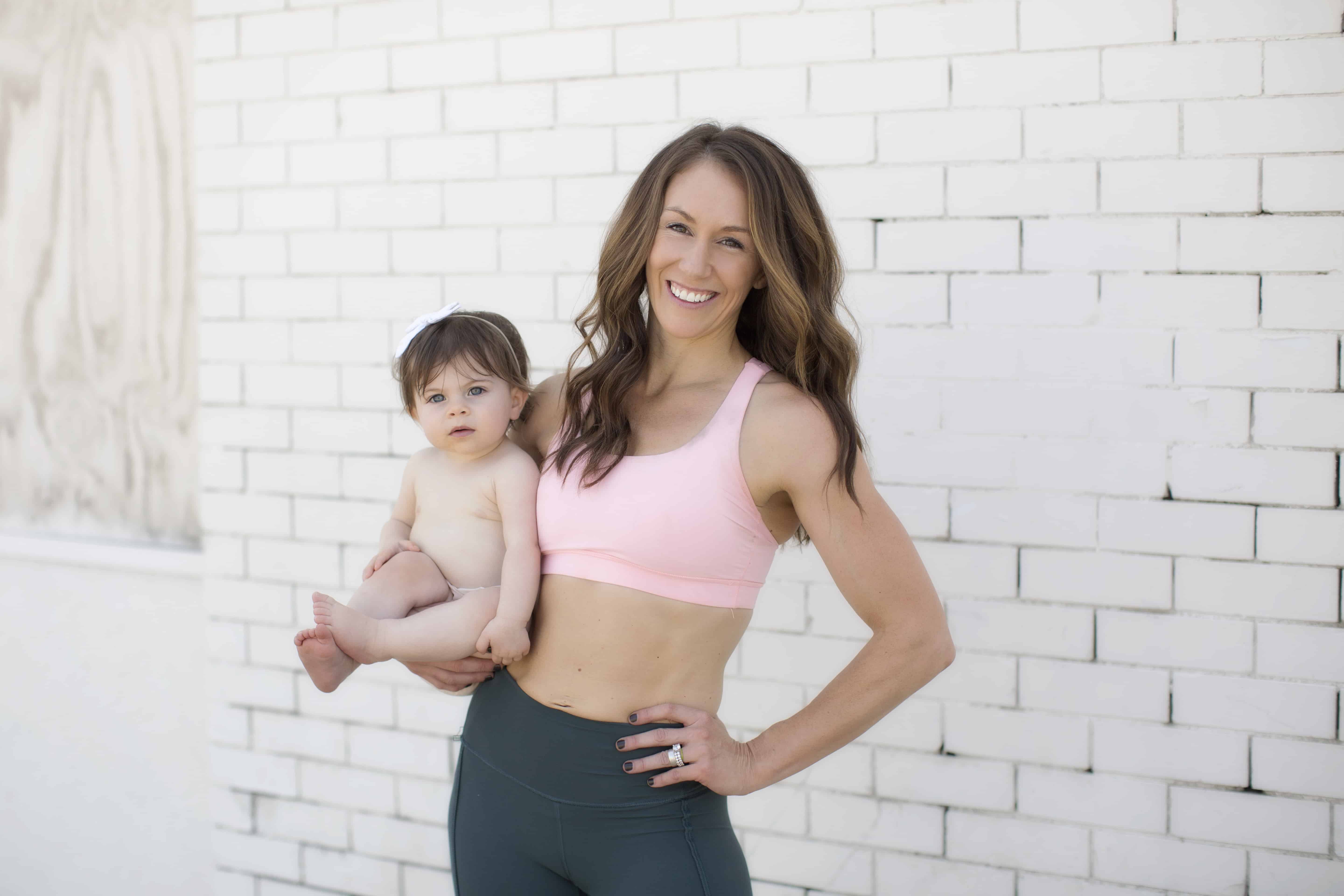
Brooke is a certified Prenatal and Postnatal Exercise Specialist with a Bachelors of Science degree in Kinesiology-Exercise Science. She is also a mom of 3 girls with more than 15 years of experience in health and fitness. Brooke’s goal at Struggles of a Fit Mom is to help motivate, educate and inspire other busy mamas who struggle with finding time, energy and motivation to take care of themselves in the chaos of motherhood.

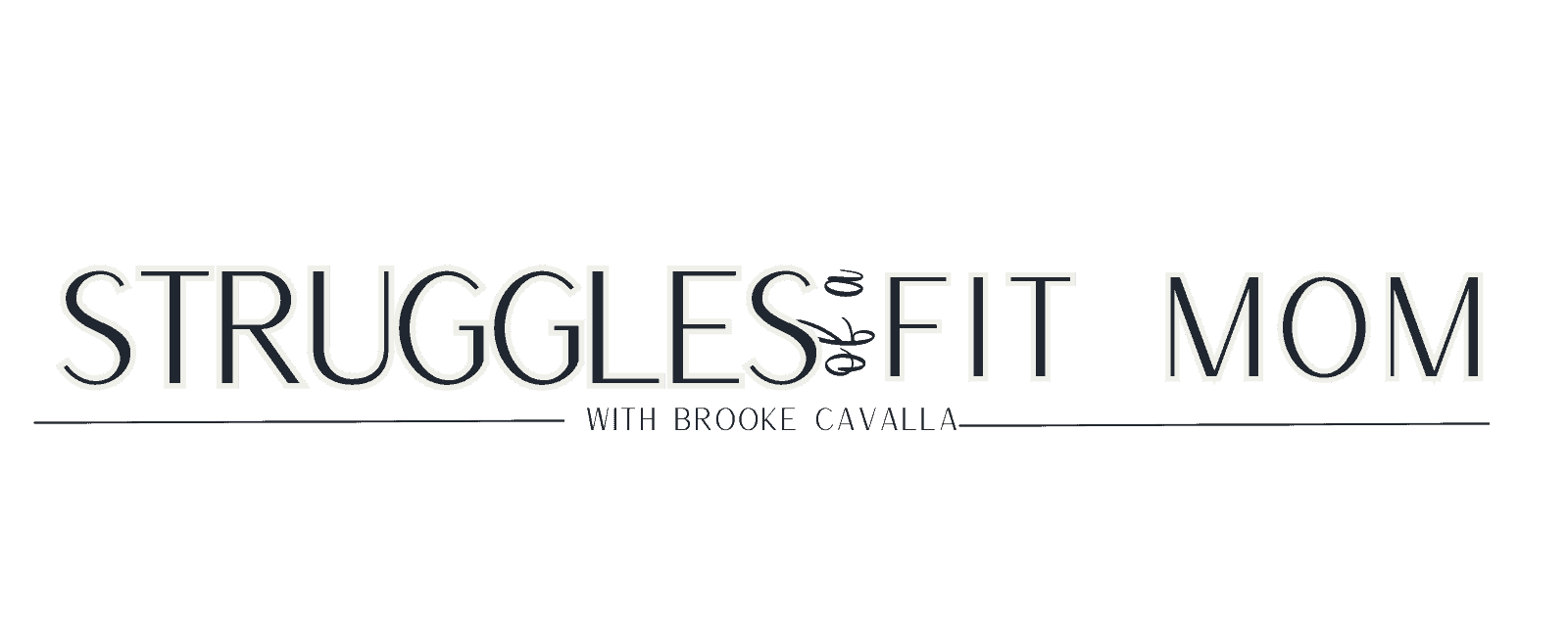
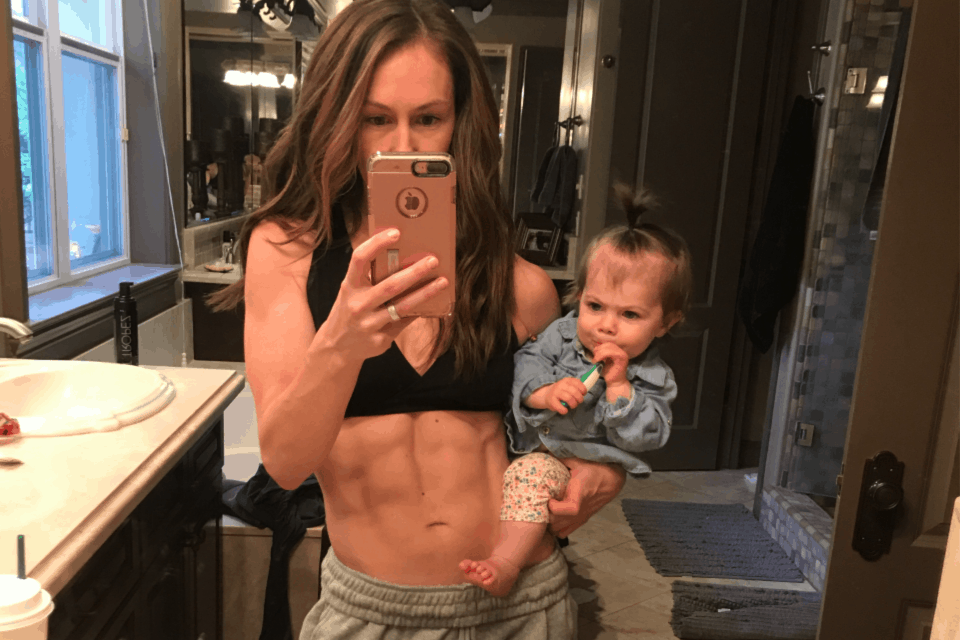
![8 Tips To Make Your Days a Breeze [as a Stay at Home Mom]](https://www.strugglesofafitmom.com/wp-content/uploads/2020/09/Blank-450-x-450.png)

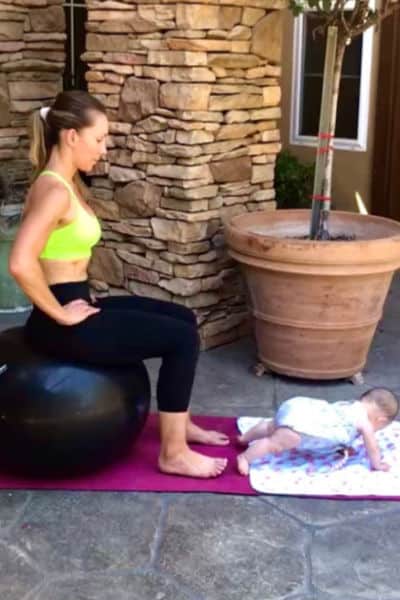
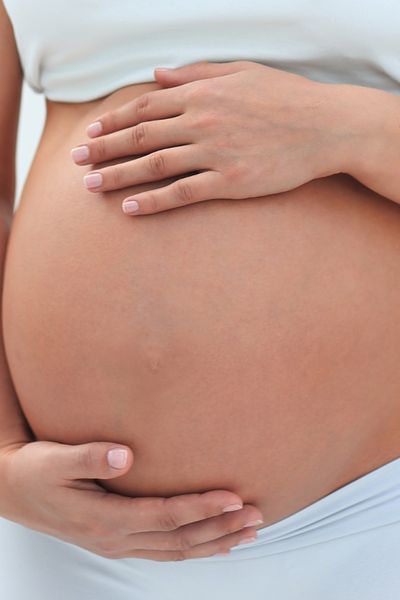
![How To Reduce a C-Section Belly Overhang Naturally [No More Hiding]](https://www.strugglesofafitmom.com/wp-content/uploads/2023/03/Featured-Images.png)
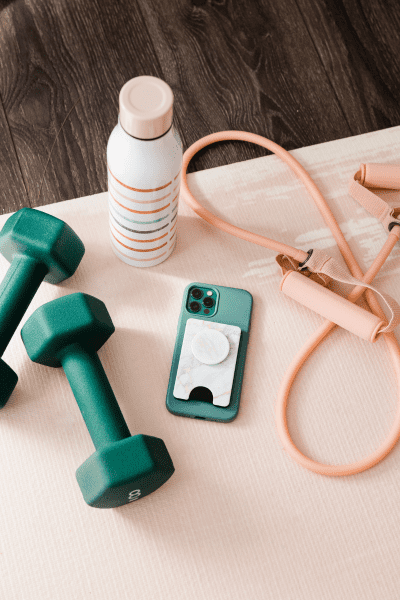
I really like your videos. I also have three children 3 and under and I’m lucky to lose weight quickly but my main goal is health and getting my belly back. I ran a 10k while pregnant with my second child although it was an accomplishment that I made it happen I felt something was wrong with my core . Your advice brought a lot of clarity on what I should focus on first. I have subscribed to your channel but I couldn’t find these specific work outs is it there? Thank you ?
Hi Renata! Great job on staying active during your pregnancy’s and running a 10k during your second pregnancy. I have a few postpartum specific workouts but I am still working on adding more. Are you looking for something specific? You are more than welcome to email me and I will help you in anyway that I can!
Hi Brooke, I will be 3 weeks postpartum on Thursday and I found this tips amazing! I will start getting them done on a daily basis. I was wondering when is the best time to start a more heavy exercise plan? After my 6weeks check up? I don’t see your email, I will like to learn more about an exercise plan for a near future and to stay healthy.
Thank you so much for the amazing exercise demonstrations!
Hi Jennifer! Congratulations on your baby! Im so glad you found this helpful and I would be happy to help you in your postpartum journey. My email is Brooke@strugglesofafitmom.com =)